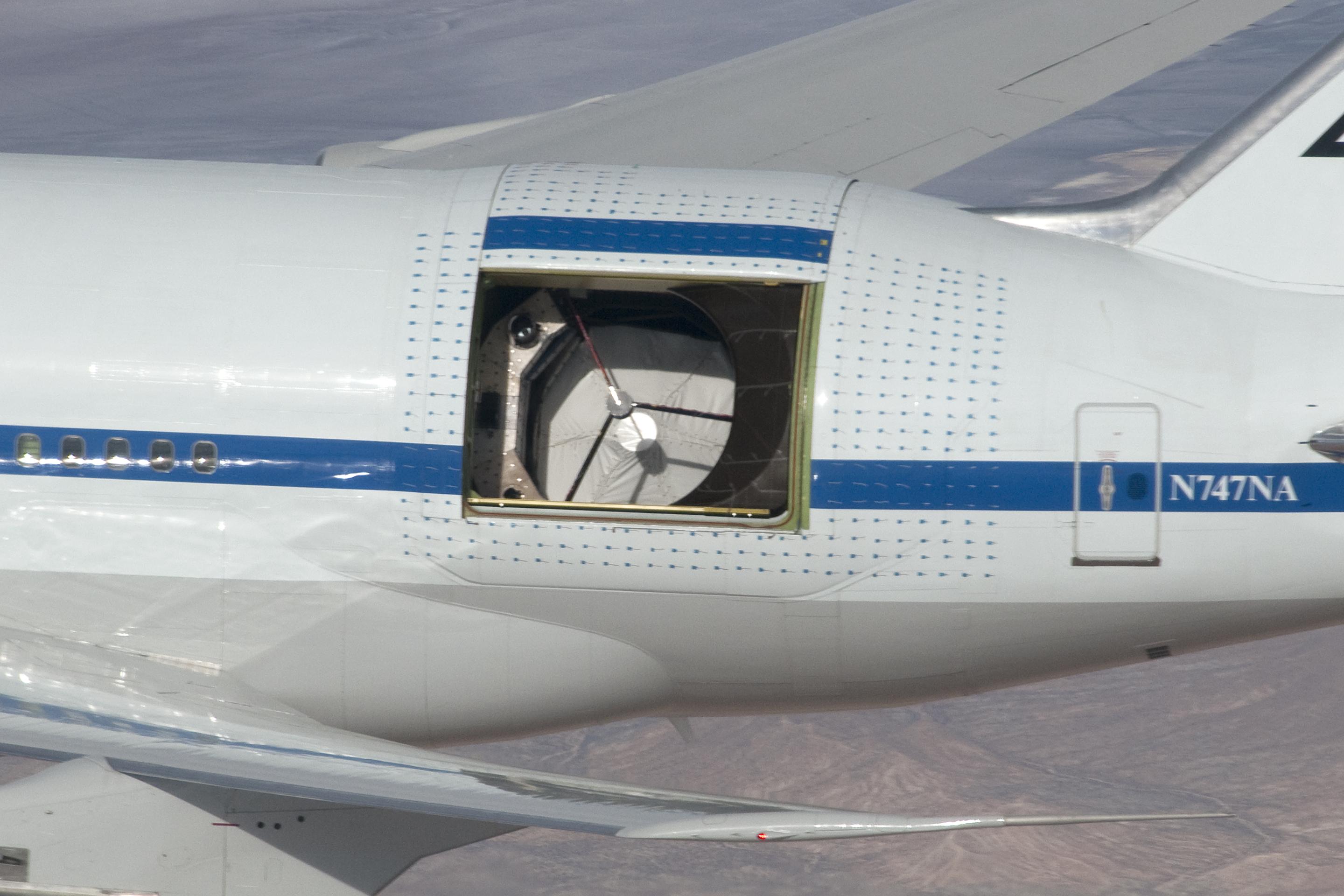The Stratospheric Observatory for Infrared Astronomy (SOFIA) was a groundbreaking project that merged advanced technology and science to study the universe in infrared light. Developed through a collaboration between NASA and the German Aerospace Center (DLR), SOFIA featured a unique approach by using a modified Boeing 747SP to host a high-tech telescope. This airborne observatory allowed scientists to explore phenomena hidden in visible light, such as star formation and interstellar processes, furthering our understanding of the cosmos.
The SOFIA Observatory
The Stratospheric Observatory for Infrared Astronomy (SOFIA) was a one-of-a-kind flying observatory designed to overcome limitations imposed by Earth’s atmosphere on infrared observations. Mounted on a modified Boeing 747SP aircraft, SOFIA featured a 2.7-meter telescope capable of observing celestial objects at altitudes of 12 to 14 kilometers, where 99% of water vapor in the atmosphere is avoided. This unique mobility allowed it to reach optimal observation sites globally, including remote regions like the southern hemisphere, enabling views of celestial phenomena not visible from stationary observatories.
The aircraft’s engineering was a marvel, with a specially designed cavity to house the telescope, stabilized to counteract vibrations and turbulence during flight. The observatory was equipped with interchangeable instruments, including spectrometers and cameras, which expanded its versatility to study everything from the birth of stars to the composition of planetary atmospheres. SOFIA’s ability to upgrade instruments throughout its operational life ensured it remained at the cutting edge of infrared astronomy.
Scientific Contributions
SOFIA’s scientific achievements spanned a wide array of fields, thanks to its unique capability to observe the universe in infrared wavelengths. One of its groundbreaking discoveries was the detection of water molecules on the sunlit surface of the Moon, a finding that transformed our understanding of lunar resources and their potential for future exploration. SOFIA also provided crucial data on the birth and evolution of stars by observing stellar nurseries hidden behind clouds of gas and dust that block visible light.
The observatory contributed to our knowledge of galactic dynamics by studying the magnetic fields in galaxies, helping scientists understand their role in star formation and galactic evolution. It also investigated the atmospheres of exoplanets and the composition of comets, shedding light on planetary system formation. Additionally, SOFIA’s ability to track transient celestial events, such as occultations, allowed researchers to capture unique insights into phenomena like the rings of distant planets.
SOFIA’s legacy lies in its ability to fill the observational gaps between ground-based and space telescopes, providing rich datasets that continue to be analyzed by astronomers worldwide. By advancing the field of infrared astronomy, it established a platform for future explorations of the universe’s most enigmatic phenomena.
Educational and Technological Impacts
SOFIA was more than just a scientific observatory; it also played a critical role in education and technological innovation. The project included a STEM engagement initiative, where educators were invited to participate in research flights alongside scientists. This experience allowed teachers to bring real-world scientific processes back to their classrooms, inspiring students to pursue careers in astronomy and aerospace fields.
On the technological front, SOFIA’s unique design pushed the boundaries of engineering. Its stabilization system for the telescope, which counteracted vibrations and movements during flight, was a remarkable achievement. Additionally, the project encouraged advancements in infrared detector technology, setting the stage for future missions. The ability to swap instruments ensured continuous improvements, creating a versatile platform for cutting-edge research.
Mid-Flight Telescope Activation
One of SOFIA’s most remarkable features was its ability to activate and operate its telescope mid-flight. During missions, the aircraft ascended to altitudes of 12–14 kilometers, where the atmosphere was clear of water vapor that obstructs infrared observations. Once at the desired altitude, the telescope door, specially designed to minimize turbulence, was opened, exposing the 2.7-meter infrared telescope to the sky.
The telescope used advanced stabilization systems to counteract vibrations and movements caused by the aircraft, allowing for precise tracking and data collection during flight. This mid-flight activation process enabled SOFIA to capture high-resolution observations of celestial phenomena, offering a unique advantage over ground-based observatories.
Challenges and the End of the Mission
Operating SOFIA presented several challenges, both technical and financial. Maintaining a flying observatory required significant resources, from aircraft maintenance to the specialized engineering needed to keep the telescope operational at high altitudes. These factors, combined with high operational costs, often led to comparisons with other, more cost-efficient space-based observatories like the James Webb Space Telescope.
As NASA’s astrophysics program shifted priorities, the decision was made to decommission SOFIA in 2022. While some critics viewed the mission as costly, proponents highlighted its scientific value and the unique data it contributed to the field of infrared astronomy. The closure of SOFIA marked the end of a bold chapter in astronomical exploration, but its legacy lives on through its discoveries and the researchers it inspired.
SOFIA’s Legacy
SOFIA’s legacy is deeply embedded in the field of infrared astronomy. Its ability to observe phenomena hidden from visible light advanced our understanding of the universe in ways ground-based telescopes could not. From unraveling the mysteries of star formation to exploring the chemistry of distant galaxies, SOFIA provided critical insights that continue to fuel research.
The observatory also demonstrated the importance of international collaboration, as seen in the partnership between NASA and DLR. This cooperation not only enabled the mission but also highlighted the value of pooling expertise and resources to tackle scientific challenges. SOFIA’s datasets remain a valuable resource for astronomers, ensuring that its contributions will continue to shape the field for years to come.
Conclusion
SOFIA stands as a testament to the ingenuity and collaborative spirit of modern astronomy. Its unique airborne platform bridged gaps between ground-based and space-based observatories, yielding scientific discoveries that reshaped our understanding of the universe. Despite its operational challenges and eventual decommissioning, SOFIA’s contributions continue to guide future missions in infrared astronomy. The observatory’s rich legacy serves as a reminder of the value of innovation and international partnership in the pursuit of exploring the cosmos.
